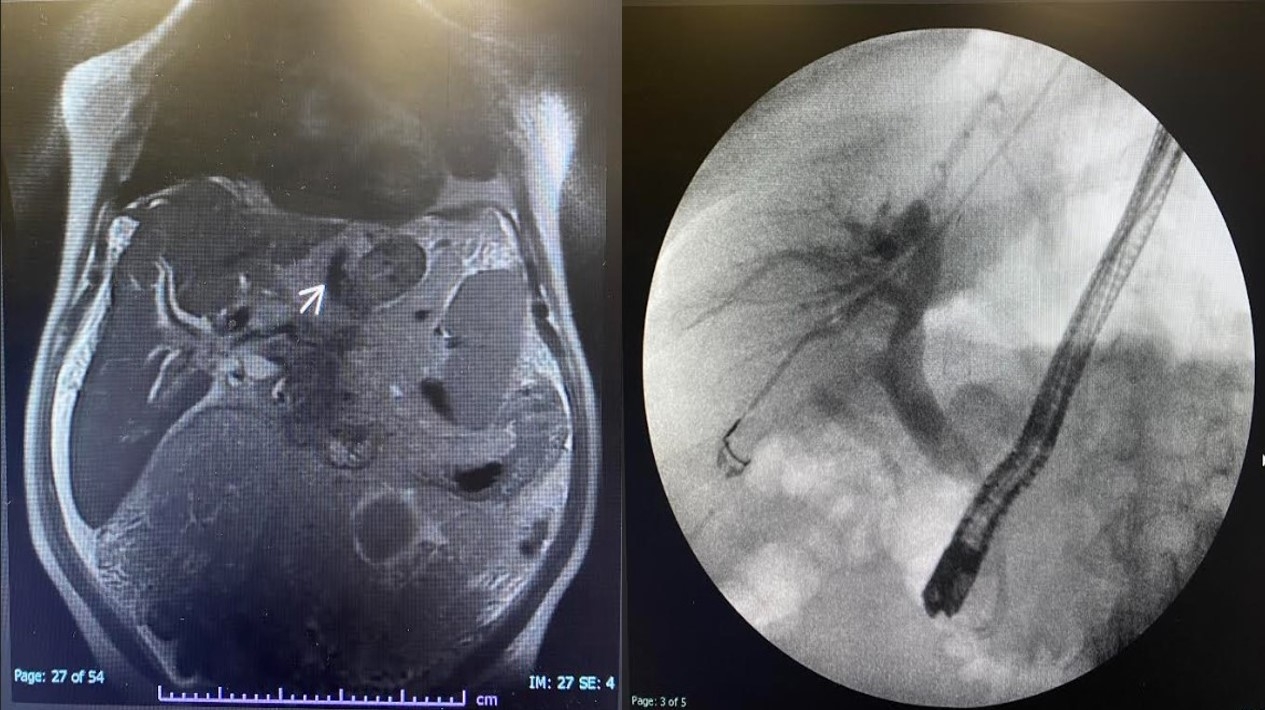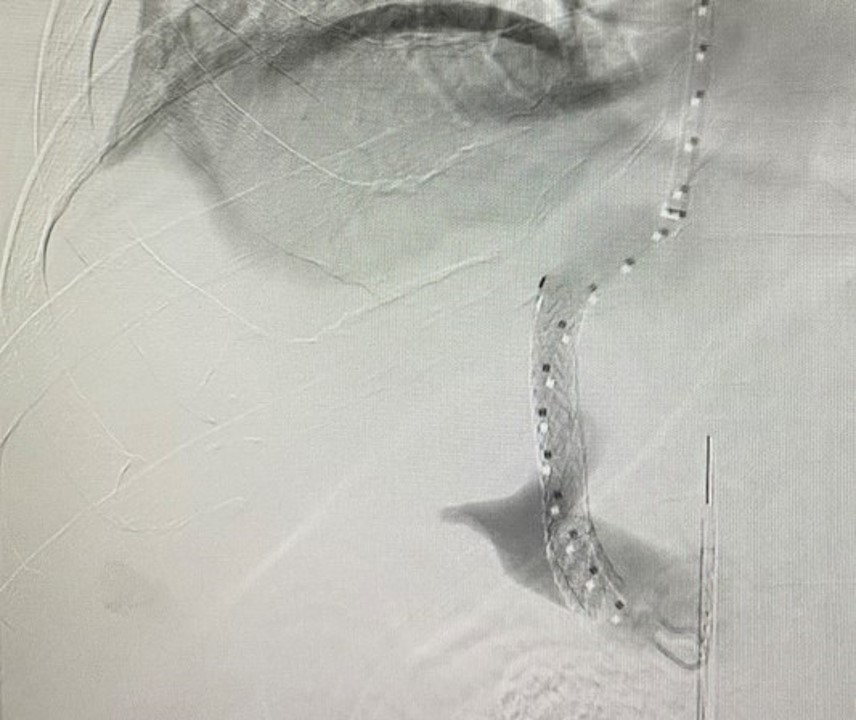Monday Poster Session
Category: Interventional Endoscopy
P3584 - Peribiliary Variceal Bleeding: Is TIPS the Answer?
Monday, October 27, 2025
10:30 AM - 4:00 PM PDT
Location: Exhibit Hall

Wael T. Mohamed, MD (he/him/his)
University of Kansas School of Medicine
Wichita, KS
Presenting Author(s)
Wael T. Mohamed, MD1, Mohamed Omar, MD1, Nathan Tofteland, MD1, William J.. Salyers, MD, MPH2, Kyle Rowe, MD1
1University of Kansas School of Medicine, Wichita, KS; 2University of Kansas School of Medicine - Wichita, Wichita, KS
Introduction: Peribiliary varices are an uncommon manifestation of chronic portal hypertension and can result in extrinsic compression and narrowing of the common bile duct. Their rarity and anatomical complexity make management particularly challenging, especially when they hinder standard endoscopic interventions.
Case Description/
Methods: A 63-year-old male with cirrhosis secondary to metabolic-associated steatotic liver disease (MASLD) and chronic portal venous occlusion presented with new-onset jaundice. MRCP revealed intrahepatic biliary ductal dilation. He was initially scheduled for endoscopic ultrasound (EUS) and endoscopic retrograde cholangiopancreatography (ERCP).
EUS demonstrated large peribiliary varices compressing the common bile duct and a distal choledocholithiasis. Duodenal bulb stenosis from extrinsic variceal compression was also noted. Due to the high risk of hemorrhage and technical difficulty, ERCP was aborted.
The patient underwent TIPS placement and splenic artery embolization to decompress the portal circulation. TIPS was deemed safe in this case, with a MELD score of 18 and no prior hepatic encephalopathy. Post-TIPS, repeat ERCP showed significant reduction in esophageal, gastric, and peribiliary varices. The biliary stone was successfully extracted, and a plastic stent was placed.
Discussion: This case underscores the critical role of TIPS in the management of peribiliary varices that cause biliary obstruction. By reducing portal pressure, TIPS can facilitate safe and effective biliary intervention in patients where traditional endoscopic access is impeded. Early recognition and multidisciplinary management are essential in such complex presentations.

Figure: Role of TIPS in reducing peri-biliary varices before ERCP

Figure: TIPS with significant reduction in HVPG and peribiliary varices disengorgement.
Disclosures:
Wael Mohamed indicated no relevant financial relationships.
Mohamed Omar indicated no relevant financial relationships.
Nathan Tofteland indicated no relevant financial relationships.
William Salyers indicated no relevant financial relationships.
Kyle Rowe indicated no relevant financial relationships.
Wael T. Mohamed, MD1, Mohamed Omar, MD1, Nathan Tofteland, MD1, William J.. Salyers, MD, MPH2, Kyle Rowe, MD1. P3584 - Peribiliary Variceal Bleeding: Is TIPS the Answer?, ACG 2025 Annual Scientific Meeting Abstracts. Phoenix, AZ: American College of Gastroenterology.
1University of Kansas School of Medicine, Wichita, KS; 2University of Kansas School of Medicine - Wichita, Wichita, KS
Introduction: Peribiliary varices are an uncommon manifestation of chronic portal hypertension and can result in extrinsic compression and narrowing of the common bile duct. Their rarity and anatomical complexity make management particularly challenging, especially when they hinder standard endoscopic interventions.
Case Description/
Methods: A 63-year-old male with cirrhosis secondary to metabolic-associated steatotic liver disease (MASLD) and chronic portal venous occlusion presented with new-onset jaundice. MRCP revealed intrahepatic biliary ductal dilation. He was initially scheduled for endoscopic ultrasound (EUS) and endoscopic retrograde cholangiopancreatography (ERCP).
EUS demonstrated large peribiliary varices compressing the common bile duct and a distal choledocholithiasis. Duodenal bulb stenosis from extrinsic variceal compression was also noted. Due to the high risk of hemorrhage and technical difficulty, ERCP was aborted.
The patient underwent TIPS placement and splenic artery embolization to decompress the portal circulation. TIPS was deemed safe in this case, with a MELD score of 18 and no prior hepatic encephalopathy. Post-TIPS, repeat ERCP showed significant reduction in esophageal, gastric, and peribiliary varices. The biliary stone was successfully extracted, and a plastic stent was placed.
Discussion: This case underscores the critical role of TIPS in the management of peribiliary varices that cause biliary obstruction. By reducing portal pressure, TIPS can facilitate safe and effective biliary intervention in patients where traditional endoscopic access is impeded. Early recognition and multidisciplinary management are essential in such complex presentations.

Figure: Role of TIPS in reducing peri-biliary varices before ERCP

Figure: TIPS with significant reduction in HVPG and peribiliary varices disengorgement.
Disclosures:
Wael Mohamed indicated no relevant financial relationships.
Mohamed Omar indicated no relevant financial relationships.
Nathan Tofteland indicated no relevant financial relationships.
William Salyers indicated no relevant financial relationships.
Kyle Rowe indicated no relevant financial relationships.
Wael T. Mohamed, MD1, Mohamed Omar, MD1, Nathan Tofteland, MD1, William J.. Salyers, MD, MPH2, Kyle Rowe, MD1. P3584 - Peribiliary Variceal Bleeding: Is TIPS the Answer?, ACG 2025 Annual Scientific Meeting Abstracts. Phoenix, AZ: American College of Gastroenterology.
